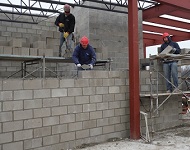
By Gregory Havel
Many of today’s new and recently remodeled buildings have some features that make them appear similar to the extent that the outward appearance may not be a good indicator how a fire will behave in those buildings.
Most buildings of most construction types are finished on the inside with gypsum drywall board, which can be covered with paint, vinyl or fabric wall coverings, or wood materials.
These buildings can also clad on the outside with masonry (concrete masonry units, brick, stone, or a veneer of thin-cut or plastic brick that is glued to the underlying wall structure), concrete, exterior insulating foam system (EIFS), stucco, or decorative panels of metal or other materials.
Although the physical properties of these interior finishes and exterior cladding are important in preventing the spread of fire from room to room and from building to building, it is the structural members that connect and separate them that have the greatest effect on an interior fire once it has outgrown its compartment of origin.
Photo 1 shows structural steel that will be enclosed by concrete masonry units and brick, which will help protect the structural steel from fire and heat.
Photo 2 shows fiberglass-faced gypsum-board sheathing over steel stud framing, which will be covered by brick or stone masonry or decorative metal panels.
Photo 3 shows the finished masonry, ready for the installation of decorative metal panels.
Photo 4 shows the interior side of a similar wall, ready for the installation of insulation and gypsum drywall board.
Photo 5 shows the interior of a similar wall after the installation of insulation and drywall board.
In the same building, the exterior claddings are separated from the interior finishes in different areas by concrete masonry, gypsum board sheathing on steel studs, and gypsum board sheathing on wood studs.
Although one- and two-hour fire resistance ratings can be achieved by any of these systems, fire will behave differently when it breaks through the drywall board into the larger, interconnected concealed spaces provided by steel and wood stud framing than if it breaks through the drywall into a space that is mostly filled with noncombustible masonry.
With the reduced time to flashover provided by today’s furniture and furnishings as well as the higher rates of heat release from these same fuels, firefighters can no longer assume that they will have time after arriving on scene to extinguish a fire before it breaks through the compartment walls into the concealed spaces. In commercial buildings and in target hazards, this information must be available to us on preincident plans.
Download this article as a PDF HERE (685 KB)
 Gregory Havel is a member of the Town of Burlington (WI) Fire Department; retired deputy chief and training officer; and a 35-year veteran of the fire service. He is a Wisconsin-certified fire instructor II, fire officer II, and fire inspector; an adjunct instructor in fire service programs at Gateway Technical College; and safety director for Scherrer Construction Co., Inc. Havel has a bachelor’s degree from St. Norbert College; has more than 35 years of experience in facilities management and building construction; and has presented classes at FDIC.
Gregory Havel is a member of the Town of Burlington (WI) Fire Department; retired deputy chief and training officer; and a 35-year veteran of the fire service. He is a Wisconsin-certified fire instructor II, fire officer II, and fire inspector; an adjunct instructor in fire service programs at Gateway Technical College; and safety director for Scherrer Construction Co., Inc. Havel has a bachelor’s degree from St. Norbert College; has more than 35 years of experience in facilities management and building construction; and has presented classes at FDIC.
MORE CONSTRUCTION CONCERNS
Fall Protection
Access Stairways and Ladders
Insulation of Exterior Walls in Cross-Laminated Timber
Welded Connections
Connecting Cross-Laminated Timber
Impalement Hazards

